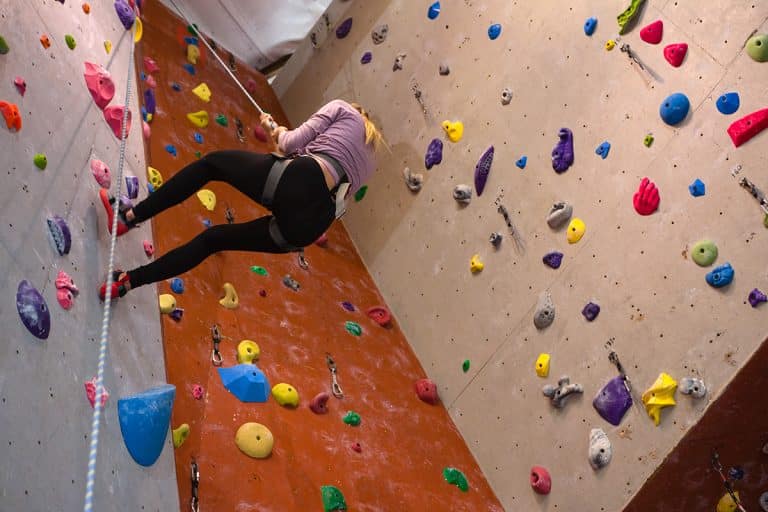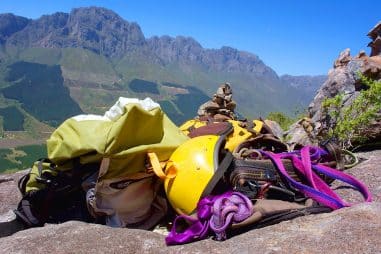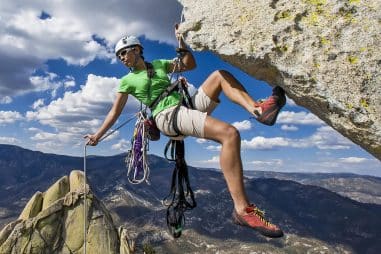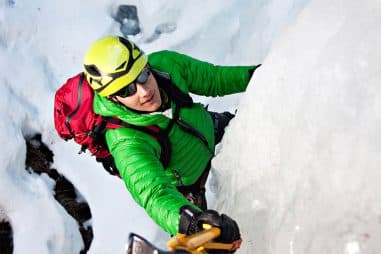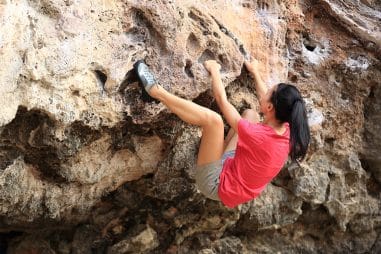There’s no doubt that climbing is fun. But it can also be dangerous if you’re not properly trained and equipped. So, if you’re ever going on a Top Roping adventure, remember to strap on your gears real tight, and to always bring a friend.
What Does Top Roping Mean?
Top Rope climbing, also referred to as top roping, is a form of climbing in which a climber ascends on a rope that has an already set up anchor.
One end of the top is attached to the climber while the other end passes through the anchor (located and set up on top of the climb), and the other end is being held down by a belayer on the ground.
This is how most gym climbs are set-up and top roping is known as the most common style used for indoor climbing installations.
Is Top Roping Free Climbing?
Top roping is one of the many types of free climbing.
A climb may be considered as free climbing if you use climbing equipment only as protection and not to help your progress. You only make progress by your sheer physical ability to move across the rock using only handholds and footholds.
Top roping checks all these boxes as the rope that runs from the climber, through the anchor, and down to the belayer is only used to protect you from any possible falling accidents.
Is Top Rope Sport Climbing?
The jury is still out if top roping is considered as sport climbing or not. It’s not really cut and dry and there is really no strict categorization whether it is traditional climbing or sport climbing.
Because of how the rope is set up and the presence of the belayer on the ground, top roping is often considered less physically demanding as compared to other forms of climbing which require greater commitment.
What is the Difference Between Top Rope and Lead Climbing?
Here’s a table to easily understand the difference between top roping and lead climbing.
| Top Roping | Lead Climbing |
|
|
How Do You Climb the Top Rope?
These are the steps that you should take if you ever want to start top roping:
- Step 1: Make sure that the rope passes through the anchor on top of the climb.
- Step 2: Tie one end of the rope securely into your body.
- Step 3: The belayer should attach the other end of the rope to their belayer device.
- Step 4: As you start to move up the wall, the belayer must take the extra rope into their belaying device.
- Step 5: Once you reach the top or if you decide to come down at any point, the belayer should lightly lower you down to the ground by controlling the rope as it slides through the belaying device.
How Do You Top Rope Outside?
If you ever want to try top roping outside the safety and comfort of your indoor gym, you would just need to follow the steps above. The most important thing is how you set up your anchors.
Before doing climbing of any kind, you may want to hike first going to the top of the cliff which is to be the location of your anchors.
In setting up you anchors, you have to remember that all anchor systems have to be:
- Solid
- Equalized
- Efficient
- Set up in several anchor points
- No sudden shock load if one anchor fails
- Angled smaller than 60 degrees
What Do You Need to Top Rope Outside?
Here’s a list of essentials that you must never go without when top roping.
For your personal climbing equipment:
- Climbing harness
- Climbing helmet
- Climbing shoes
- Belay device
For your anchor equipment:
- Climbing rope
- Slings
- Webbing
- Carabiners to connect the harness to the rope
- Locking carabiners
- Quickdraws
Aside from the above, chalk and chalk bag is optional. If you sweat quite a bit while climbing, then it is best to get a hold of this one too.
Can You Top Rope With Static Rope?
It is not generally advisable to use static rope in top roping. This is because static ropes stretch very little and, while they are great for hauling loads up or lowering down an injured climber, it is not tested and certified for loads used in top roping or lead climbing.
The good news is, New England Ropes started manufacturing static ropes especially made for top roping.
For your safety, you should always inform the belayer that you are using static rope instead of the usual dynamic rope because the belaying for static rope is different.
Can You Top Rope by Yourself?
Top roping is a two-man job and it is never wise to do it by yourself.
Although it is widely considered as the safest form of climbing, it is only considered as such because of the anchor and the belayer who will support and guide you while you move up and down.
How Do I Get Better at Top Roping?
There is no better way to get better at something than to practice, practice, and practice!
If you want to take top roping seriously, you should climb more to get better at it. Once you’re confident in your climbing ability, you should then practice down climbing.
Another tip is to communicate well with your belayer. Your life is in the belayer’s hands (literally and figuratively) so you should always be open to your buddy whether it be your climbing condition down to the type of rope that you will be using.

